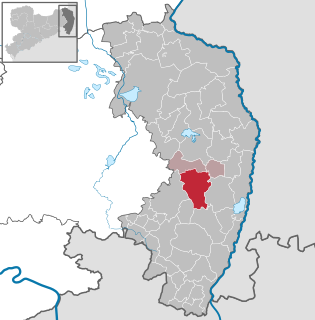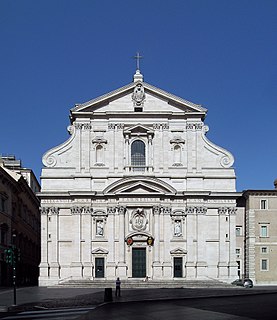
Schloss Altenstein is a Schloss or palace upon a rocky hill on the south-western slope of the Thuringian Forest, not far from Eisenach, Thuringia, Germany. It was the summer residence of the Dukes of Saxe-Meiningen, and is surrounded by 160 hectares of English landscape garden, which contain, among other objects of interest, a cavern 300 metres long, through which flows a large and rapid stream.

Schönhausen Palace is a Baroque palace at Niederschönhausen, in the borough of Pankow, Berlin, Germany. It is surrounded by gardens through which the Panke river runs. The palace is maintained by the Prussian Palaces and Gardens Foundation Berlin-Brandenburg and reopened to the public in 2009 after extensive restoration.

Schloss Hohenheim is a manor estate in Stuttgart, eponymous of the Hohenheim city district. The original castle was a fief of the County of Württemberg, recorded for the 12th century. The estate fell into the possession of Charles Eugene, Duke of Württemberg in 1768, who had it re-built as a Rococo style manor with extensive gardens and residential palace for his future wife, Franziska von Hohenheim. The estate was the main ducal residence during 1772–1797, when it fell to the city of Stuttgart. An Agricultural Educational Testing and Model Institution was housed here in 1818, and the estate remains in use by the Horticulture and Agriculture Departments of the University of Hohenheim.

Jelenia Góra Valley in Poland is a big valley at the Silesian northern side of the Western Sudetes and next to Kłodzko Valley the largest intramontane basin of the Sudetes. It is situated at an altitude of 250–400 meters above sea level and covers an area of 273 km2. In the 19th century, the lovely landscape attracted the Prussian high nobility, which built magnificent palaces, manors and parks. The enormous number of stately homes turned the valley into one of the most important garden landscapes in Middle Europe.

Schloss Ebenrain is a former country residence in Sissach, in the canton of Basel-Country, Switzerland. Built in 1774-1776, it is considered the most significant late baroque residence in northwestern Switzerland. It is now a public facility and the site of an agricultural school. It is listed as a Swiss cultural property of national significance.

Schloss Köpenick is a Baroque water palace of the Hohenzollern electors of Brandenburg which stands on an island in the Dahme River surrounded by an English-style park and gives its name to Köpenick, a district of Berlin.

The Schloss Britz is the former manor-house of the historical Rittergut and village Britz, now a district of Berlin-Neukölln. Today it is the headquarters of the cultural organization Kulturstiftung Schloss Britz and includes authentic reconstructed rooms from around 1880. The house is a museum demonstrating interiors of the Gründerzeit era. The manorial park is also well preserved with its mature trees and its 1890s system of trails. In 1997 the park was honored with the German Gustav Meyer Prize for the accuracy and historic authenticity of the reconstruction.

Gaussig House is a manor house in Palladian style located in the district Bautzen in the German state of Saxony approximately 6 km southwest from the Upper Lusatian central city Bautzen. Extending over some 75 acres (300,000 m2), nestled in beautiful natural surroundings and bordered by the Grosse Picho hill to the south, lies one of Upper Lusatia’s largest landscape parks. Gaussig House, the orangery, the church and vicarage, and the estate form the centre of Gaussig village.

Purdi is a village in Paide Parish, Järva County in northern-central Estonia.

Moyland Castle is a moated castle in Bedburg-Hau in the district of Kleve, one of the most important neo-Gothic buildings in North Rhine-Westphalia. Its name derives from the Dutch word Mooiland which means "beautiful country". The name was probably coined by Dutch workers, which the former owner Jacob van den Eger of the Lower Rhine had brought to his property to drain the surrounding wetlands.

Schloss Stainz is a former monastery of the Augustinian Canons in Stainz in Styria, Austria. Today the Baroque complex belongs to the Counts of Meran and hosts two museum collections from the Universal Museum Joanneum.

Pillnitz Castle is a restored Baroque palace at the eastern end of the city of Dresden in the German state of Saxony. It is located on the bank of the River Elbe in the former village of Pillnitz. Pillnitz Castle was the summer residence of many electors and kings of Saxony; it is also known for the Declaration of Pillnitz in 1791.

Jegenstorf Castle is a castle in the municipality of Jegenstorf of the Canton of Bern in Switzerland. It is a Swiss heritage site of national significance.

Schloss Allner is a fifteenth-century castle in Rhein-Sieg-Kreis, North Rhine-Westphalia, Germany. It is located on the southern slope of the Nutscheid Ridge, on the north bank of the River Sieg, and just northeast of the Allner See. It lies to the northeast of the town of Hennef, east of the district of Allner.

Schloss Bothmer is a Baroque palatial manor house ensemble in northern Germany. It was built for Count Hans Caspar von Bothmer to designs by architect Johann Friedrich Künnecke in 1726–32. It remained the property of the Bothmer family until 1945. It is today owned by the State of Mecklenburg-Vorpommern and, following a renovation in 2009–15, open to the public. It is the largest Baroque-era country house ensemble in Mecklenburg-Vorpommern.

Schloss Haimhausen is a Schloss in the Bavarian town of Haimhausen, Germany.

Ittigen Castle is a historical country house in Ittigen in the Canton of Bern in Switzerland.
The House of Egloffstein is an ancient Franconian aristocratic family (Uradel) with an eponymous family home in the hill region of Franconian Switzerland in the Bavarian province of Upper Franconia. The family first appears in the records in 1187 with a Heinrich genannt Stuchs who is also the progenitor. The house belongs to the brotherhood of Franconian Imperial Knights.
























